EICR for Commercial Properties in England
An Electrical Installation Condition Report (EICR) is an evaluation of a commercial property’s electrical installation. Conducted by an approved contractor or qualified electrician, an EICR examines the condition of electrical installations and systems and determines if they comply with national safety standards.
After the assessment, landlords and business owners receive a formal document provided by the contractor or electrician. This document states if your electrical systems are in good working condition or if some defects or deficiencies need to be corrected.
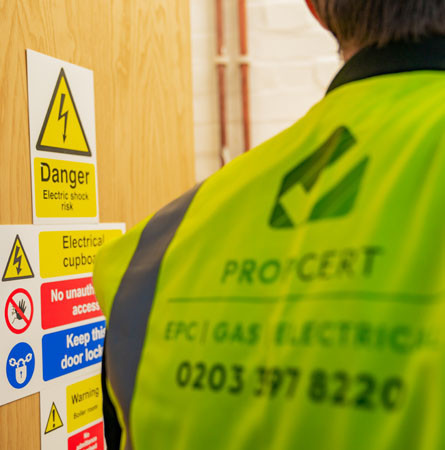
Guesthouses, HMOs
Public buildings like hotels, cinemas, hospitals, schools and sports grounds.
Commercial Offices
Shops and warehouses
Construction Sites
Farms & Industrial factories

Why does my property need a commercial EICR?
Laws in England require businesses to comply with specific electrical safety standards to keep their property, customers and employees safe. These regulations include:
Electricity at Work Regulations 1989
Employers must ensure their electrical systems are safely installed and maintained to protect their employees in the workplace. Businesses must continually monitor the condition of their electrical systems through regular assessments and testing.
Landlords and Tenants Act 1985
Landlords of commercial and domestic buildings must exercise all precautions to protect their clients from injury and damage caused by electric fires and shocks. An EICR is required to ensure that all systems have been checked and tested by a qualified electrician.
A commercial EICR proves that you have complied with these standards, ensuring that the property is safe for employees and customers. These electrical safety regulations apply to commercial properties including:
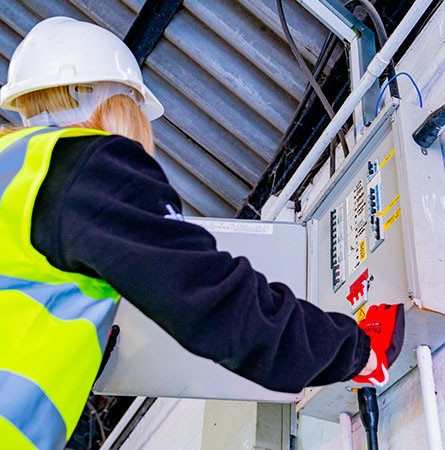
All commercial electrical systems and installations must be checked and tested by a qualified electrician at least once every five years. Some properties require more frequent testing for reasons including:
Why should I have my electrical system periodically tested?
The lack of an EICR and failure to complete periodic testing makes you liable under UK law for damage or injuries caused by an electrical fire or shock. Without an EICR, it is difficult to prove that all measures were taken to ensure the safety of employees and customers.
Some insurance companies also require an EICR as part of their policy. This document is proof to the insurer that you took the necessary steps to reduce the risk of an electrical fault in your property. If you need to make a claim because an electrical-related accident happens, the insurance company is more likely to cover the damages with an EICR.
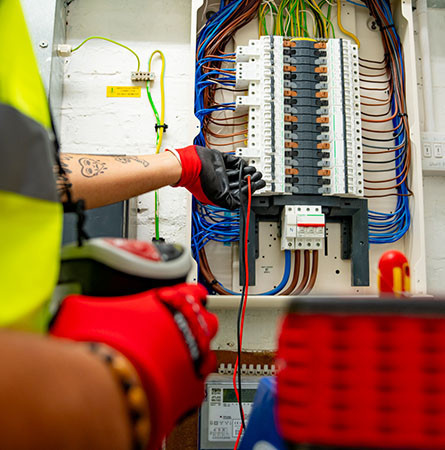
WHY DOES MY PROPERTY NEED AN Commercial EICR?
Conducting a regular EICR gives you several benefits, such as:
Insurance
Insurance companies may require regular electrical testing. To claim damages from electrical faults, you must show proof of taking security measures, like an EICR Certificate. Check your policy to confirm if an EICR is necessary as per your insurer's requirements.
Compliance with regulations
Having an updated Commercial Electrical Installation Condition Report (EICR) demonstrates your compliance with legal responsibilities.
Legal protection
An up-to-date EICR demonstrates your commitment to safety. In the event of electric-related incidents, such as fire or injury, the EICR serves as evidence of fulfilling your duties as a responsible landlord or business owner, potentially avoiding expensive legal consequences and damage claims.
Safety
Regular electrical testing ensures safety, reduces risks of fire and shock, and provides peace of mind for property owners, customers, and staff.
Energy efficiency
Lowering energy consumption means cost savings for businesses, while identifying and rectifying electrical faults prevents expensive damages from occurring.
Cost-effectiveness
Reducing your energy consumption means your business saves money. Identifying electrical faults also means correcting them before they cause costly damage.
Step 1: Getting in touch with an electrical contractor
The nature of a commercial EICR means that the electrician handling your inspection must be certified to work on large electrical systems. When hiring a contractor for an EICR, make sure the electricians have Level 3 diplomas from the National Vocational Qualification (NVQ) in the fields of:
Commercial electricians must also be accredited by governing bodies like the National Inspection Council for Electrical Installation Contracting. These qualifications ensure that the inspection and necessary remedial work comply with electrical safety regulations.
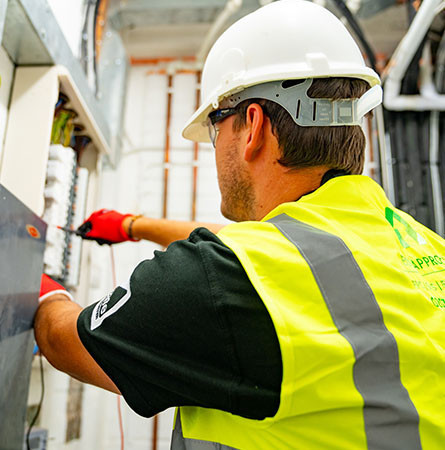
Step 2: Setting operational limitations and extent of testing
Before the electrician arrives, they’ll discuss the extent of testing and operational limitations in your property. There might be certain areas in the property where assessment and testing cannot be undertaken. The electrician will note down these limitations and explain the reasons for this in the report.
An example of operational limitations includes installations concealed within the fabric of the building since testing would require reconstruction of the flooring, wall or roof space. You may also exclude other installations from being examined and tested, although doing so will not give you a full and accurate report of the condition of your electrical system.
Step 3: Inspection and testing
The electrician will inspect and test all electrical systems on your property (excluding those that are part of the agreed limitations), taking note of issues such as:
Step 4: Report and remedial work
After the assessment and testing, the electrician will generate a report that will be signed by their qualified supervisor. A copy will be sent to you, detailing the findings and recommendations of the inspection.
The law requires landlords to ensure their electrical installations are checked by a qualified person every five years.
Likewise, it is their responsibility to maintain the integrity of the installations throughout the tenant's stay.
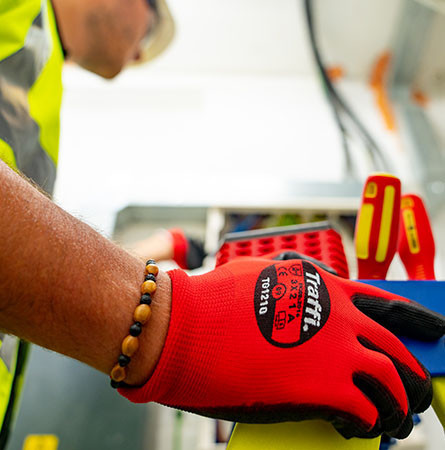
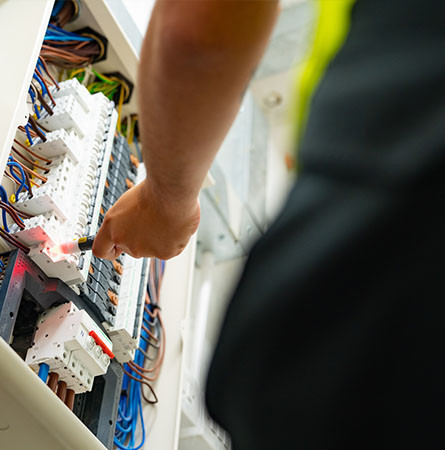
An EICR should be conducted by an experienced electrical engineer or electrician.
For commercial and rented properties, the contractor will first discuss the operational limitations with the client. The inspection might require a few minutes of downtime, or the client might have to shut down their phone lines or servers while the assessment is ongoing.
Other limitations include areas of a property that an electrician should not access, such as cables in floors and walls that might require you to cut out the plaster or flooring.
Both electrician and client must agree on a sampling rate, which determines the percentage of sockets to be tested. The two parties may agree on increasing the sample size should any faults occur during the inspection.
To perform an EICR test, the electrician will disconnect the electrical installation from the property’s main power supply. They will check the installation based on the standards set by the IET’s Wiring Regulations.
The cost of a commercial EICR depends on your contractor and the extent of the assessment. Comprehensive electrical inspections take around five hours to complete and costs around £120 to £150 for a two-bedroom flat, excluding VAT. Assessments for commercial properties usually cost £15 to £20 per circuit tested.
Expect to pay more for additional repairs and replacements that your electrician may recommend after the EICR inspection.
Stay compliant with building regulations and maintain the safety of your electrical systems with an EICR from Energy Performance Certificates.
By 1 July 2020, a landlord must give a tenant an accomplished EICR before their move-in date. The rules will apply only to new tenancies.
By 1 April 2021, a landlord must supply any current tenants with an EICR
Failure to comply with regulations can cost fees of up to £30,000
We are the trusted provider of energy performance certificates on the market, and we have earned the trust of over 78,000 clients. Our pool of qualified electricians and engineers have inspected and tested commercial properties of all sizes, performing their job quickly and thoroughly.
Get your commercial electrics tested by professionals. To get a quote, fill out Our form or call 020 3397 8220.
WHAT HAPPENS IF I DON’T PASS A COMMERCIAL EICR?
When an EICR report identifies electrical system issues, an Unsatisfactory result indicates necessary remedial work. The electrician will provide a fixed price quotation and specify a code to indicate the risk level and required action.
C1
Danger present. Risk of injury.
C2
Potentially dangerous.
C3
Improvement recommended.
FI
Further checks required without delay.
EICR TESTING BY ENERGY PERFORMANCE CERTIFICATES
During your commercial EICR test, the electrician will disconnect the electrical installation from the property's main power supply. They will inspect the installation according to the standards set by the IET's Wiring Regulations.
UKs Largest Provider Of Property Certificates
We inspect over 5,000 properties a month. No property is too big or too small for our services.
Trusted
We're rated Excellent by Trustpilot. Our local electricians have the necessary certifications to carry out EICR inspections.
Comprehensive Testing
All our EICR inspections are conducted by a fully qualified Inspector.
Fast Turnaround
We conduct tests on your schedule to minimise any down time for your business. We work quickly and thoroughly to limit disruption.
Excellent Customer Service
Our customer service team will support you through every step of the way and are happy to answer your questions and queries.
Low Prices
We take pride in giving you transparent pricing with no hidden or extra costs.
On average, an EICR inspection takes one to four hours. The length of the test depends on the size of the property, the accessibility of electrical systems and the number of electrical equipment, among other factors.
Additional inspection may be required, depending on the electrician’s findings from the comprehensive assessment.
After the inspection, the electrician will issue an EICR that you keep until the next inspection date. This is not a certificate, but simply a report that details the overall condition of your installation and the remedial work required, if needed.
The EICR will specify damages, defects, deterioration and other conditions that could put everyone in the building at risk. Pictures might be added to the report to emphasise areas of concern.
If your EICR report reveals issues with your electrical system, the results will come out as “Unsatisfactory,” meaning there is remedial work to be done. The electrician will also provide a fixed price quotation for the remedial work.
The electrician will indicate a code to specify the extent of the risk and the required action:
Code 1: Danger present. Occupants are at risk of injury and immediate action is needed.
Code 2: Potentially dangerous. Urgent remedial action is needed to make the electrical installation safe.
Code 3: Improvement recommended. This is the only EICR classification code that indicates your electrical system poses no danger, but improvements can be made.
FI: Further investigation is required. This means the contractor can’t determine the safety of the installation without additional information or investigation. An example of this is the lack of a main protective bonding of a Lightning Protection System (LPS), where the contractor must consult with the designer to confirm that it is safe to bond the LPS.
The Electrical Safety Standards require that you resolve any electrical issues within 28 days beginning with the day when you received the recommendation from the electrician.
Once the necessary corrective work is finished, the electrician will issue an EICR Certificate of Safety to verify that your electrical systems are safe.
After obtaining written confirmation from the electrician that further investigation or remedial work in the property is required, make copies and send them to each tenant within 28 days of completion of the corrective action. A copy of the report must also be sent to the local housing authority within the same time frame.
Failure to correct issues within the timeframe makes you at risk to penalties. You’ll receive a written notice from the local housing authority requesting you to address the remedial work within 21 days.
If corrective action is not completed within the given period, the local housing authority arranges for an authorised person to enter your premises to take remedial action.
The Electrical Safety Standards recommend that an EICR should be conducted at intervals of no more than five years.
A qualified electrician may recommend a more frequent inspection for the following reasons:
Age of installation: An EICR needs to be carried out regularly for old electrical systems.
Type of property: Properties with swimming pools need a more frequent assessment. It is recommended that these types of properties are tested every one to three years.
Environmental conditions: A property needs to be inspected right away after fire or flooding to determine the extent of the damage of the electrical installations.
Misuse of the installation: More frequent testing is required if the electrical system was tampered with or vandalised.
Change in usage of the property: There could be a change of tenancy in a rental property, or a property is being prepared to be purchased or sold. Aside from ensuring that the electrical system is safe, an EICR helps determine if remedial work needs to be performed before the property changes tenancy.
Your EICR serves as proof that you complied with electrical safety standards and did the reasonable steps to ensure the safety of all occupants of your property.
You are required to give copies of EICR to the following people:
Existing tenants of the residential premises. Copies must be given to them within 28 days after testing and inspection.
New tenants before they occupy the premises. Prospective tenants may also request for a copy of the EICR before agreeing on a sale.
The local housing authority. A copy must be given to them within seven days after you’ve received a written request from them.
The electrician carrying out the next EICR inspection. This will give them a background of your electrical system before starting a new inspection.
After inspecting and testing, the electrician will apply a label to the electrical installation, indicating the date of the inspection and the recommended date for the next EICR test. The electrician must also record the next inspection date on the EICR.
The electrician may recommend a more periodic inspection based on several factors, and the recommendation must be justified in the report.
The average cost of an EICR for a two-bed flat is £120 to £150. The price can go up depending on several factors like:
Location: Properties in the city tend to have a higher cost of EICR.
Age of the property: Older properties require a more thorough inspection because of the deterioration and wear and tear of the electrical system.
Size of the property: Larger properties require a more extensive inspection.
Type of property: An industrial facility will need to be examined more thoroughly than a flat or hostel.
The extent of testing: Although we encourage a thorough inspection of all systems, it might not be feasible given factors like your property’s layout or the nature of your business. Asking the electrician or engineer to inspect only certain areas of the property lowers the cost but may not provide a complete picture of the condition of your electrical system.
Accessibility and condition of the electrical system: If your electrical installations are difficult to access, or if they have deteriorated over time, the contractor might charge higher.
Make sure that your EICR inspection is worth every penny with these tips:
Hire a qualified electrician or engineer
Choose an electrician that has relevant accreditations, such as the National Inspection Council for Electrical Installation and the Electrical Contractors’ Association. These governing bodies evaluate electrical contractors to ensure they meet technical and safety standards. Ask for relevant certifications from the contractor before they show up on your property.
Read up on relevant regulations
It might seem like a tiresome task but taking the time to read electrical safety regulations ensures that you are aware of the measures needed to make your property safe for tenants and employees. You might even find aspects from these regulations that you still have to address.
Conduct a preliminary inspection of your property
Before an inspection by the contractor, conduct a visual inspection of your electrical system and appliances and take note of visible problems. This minimises any issues that your contractor will detect during the EICR test. A preliminary inspection also determines which areas of the electrical system you can’t reach and have to be assessed by a qualified electrician.
Remedy issues found after a visual inspection
Once you find damaged extension cords, sockets and electrical fittings, replace them immediately. Tape extension cords, wires and cables to floors and walls when necessary. Install ground fault circuit interpreters in areas where there is a greater risk of electric shock, like bathrooms and swimming pools.
Inform your tenants beforehand
Send a memo to your tenants that an EICR will be performed on the property. Indicate the date, how long the testing will take and what disruptions to their daily activities they can expect. This allows tenants to plan how they can continue their activities while the inspection is ongoing.